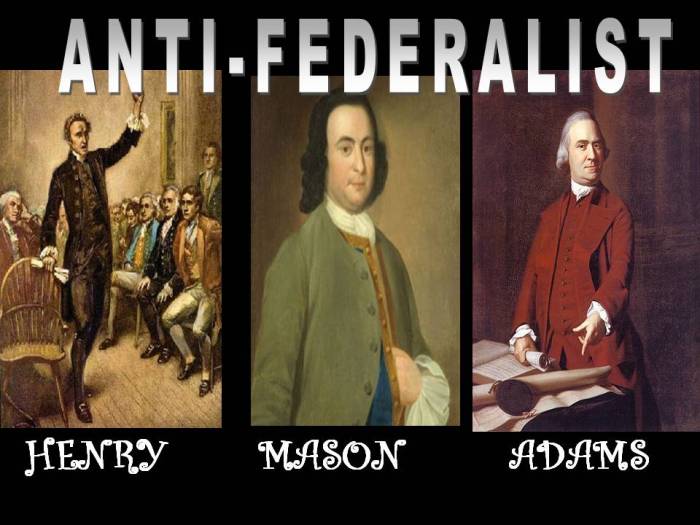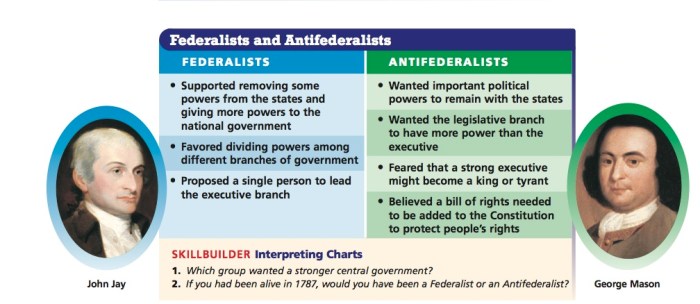Federalists and anti-federalists fight over the constitution newsela answers, a topic that has captivated historians and political scientists for centuries. This heated debate, which shaped the very foundation of the United States government, pitted two distinct groups with opposing visions for the nation’s future.
The Federalists, led by Alexander Hamilton, James Madison, and John Jay, advocated for a strong central government capable of fostering economic growth and maintaining order. On the other hand, the Anti-Federalists, spearheaded by Patrick Henry and George Mason, favored a decentralized government that preserved states’ rights and individual liberties.
Historical Context

The Constitutional Convention was convened in 1787 to address the weaknesses of the Articles of Confederation, which had proven inadequate in governing the newly independent United States. The political climate was marked by concerns about the balance of power between the states and the central government, as well as the protection of individual rights.
The Federalists, led by Alexander Hamilton and James Madison, argued for a strong central government that could regulate commerce, raise revenue, and maintain a standing army. The Anti-Federalists, led by Patrick Henry and Samuel Adams, opposed a strong central government and favored greater state autonomy.
Key Issues in the Debate
The specific provisions of the Constitution that were contested included:
- The establishment of a strong executive branch with veto power
- The creation of a bicameral legislature with representation based on population
- The inclusion of a Bill of Rights to protect individual liberties
The Federalists argued that a strong central government was necessary to promote commerce, maintain order, and defend the nation from foreign threats. The Anti-Federalists argued that a strong central government would lead to tyranny and the erosion of state power.
The Ratification Process
The ratification process was fiercely contested. The Federalists published a series of essays, known as the Federalist Papers, to defend the Constitution. The Anti-Federalists responded with their own essays, known as the Anti-Federalist Papers.
The Federalists used a variety of tactics to secure ratification, including promising to add a Bill of Rights to the Constitution. The Anti-Federalists were unable to prevent ratification, but they succeeded in shaping the final version of the Constitution.
Impact on American Government: Federalists And Anti-federalists Fight Over The Constitution Newsela Answers

The Federalist-Anti-Federalist debate had a profound impact on the structure and principles of the US government. The Constitution established a strong central government with limited powers, and it included a Bill of Rights to protect individual liberties.
The debate also established the principle of federalism, which divides power between the federal government and the states. This principle has remained a cornerstone of American government to this day.
Relevance to Contemporary Politics

The Federalist-Anti-Federalist debate continues to shape political discourse in the United States. Many of the issues that were debated during the Constitutional era, such as the balance of power between the federal government and the states, and the protection of individual rights, remain relevant today.
For example, the debate over the Affordable Care Act can be seen as a modern-day version of the Federalist-Anti-Federalist debate. The Affordable Care Act expanded the role of the federal government in healthcare, while opponents argued that it was an unconstitutional infringement on state power.
General Inquiries
What were the key issues debated by Federalists and Anti-Federalists?
The key issues included the extent of federal power, the role of states, the protection of individual rights, and the establishment of a national bank.
How did the Federalist Papers contribute to the ratification process?
The Federalist Papers, a series of essays written by Hamilton, Madison, and Jay, provided persuasive arguments in favor of the Constitution and helped sway public opinion towards ratification.
What is the significance of the Bill of Rights in relation to the Federalist-Anti-Federalist debate?
The Bill of Rights, which was added to the Constitution shortly after its ratification, addressed many of the concerns raised by Anti-Federalists regarding individual rights and limited the powers of the federal government.